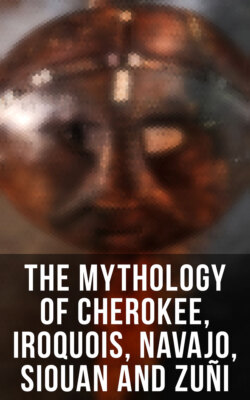Читать книгу The Mythology of Cherokee, Iroquois, Navajo, Siouan and Zuñi - James Mooney - Страница 96
На сайте Литреса книга снята с продажи.
Thunder-Gods
ОглавлениеNorth America is rich in thunder-gods. Of these a typical example is Haokah, the god of the Sioux. The countenance of this divinity was divided into halves, one of which expressed grief and the other cheerfulness—that is, on occasion he could either weep with the rain or smile with the sun. Heat affected him as cold, and cold was to him as heat. He beat the tattoo of the thunder on his great drum, using the wind as a drum-stick. In some phases he is reminiscent of Jupiter, for he hurls the lightning to earth in the shape of thunderbolts. He wears a pair of horns, perhaps to typify his connexion with the lightning, or else with the chase, for many American thunder-gods are mighty hunters. This double conception arises from their possession of the lightning-spear, or arrow, which also gives them in some cases the character of a war-god. Strangely enough, such gods of the chase often resembled in appearance the animals they hunted. For example, Tsui 'Kalu (Slanting Eyes), a hunter-god of the Cherokee Indians, seems to resemble a deer. He is of giant proportions, and dwells in a great mountain of the Blue Ridge Range, in North-western Virginia. He appears to have possessed all the game in the district as his private property. A Cherokee thunder-god is Asgaya Gigagei (Red Man). The facts that he is described as being of a red colour, thus typifying the lightning, and that the Cherokees were originally a mountain people, leave little room for doubt that he is a thunder-god, for it is around the mountain peaks that the heavy thunder-clouds gather, and the red lightning flashing from their depths looks like the moving limbs of the half-hidden deity. We also find occasionally invoked in the Cherokee religious formulæ a pair of twin deities known as the 'Little Men,' or 'Thunder-boys.' This reminds us that in Peru twins were always regarded as sacred to the lightning, since they were emblematic of the thunder-and-lightning twins, Apocatequil and Piguerao. All these thunder-gods are analogous to the Aztec Tlaloc, the Kiche Hurakan, and the Otomi Mixcoatl.10 A well-known instance of the thunder- or hunter-god who possesses animal characteristics will occur to those who are familiar with the old English legend of Herne the Hunter, with his deer's head and antlers.
The Dakota Indians worshipped a deity whom they addressed as Waukheon (Thunder-bird). This being was engaged in constant strife with the water-god, Unktahe, who was a cunning sorcerer, and a controller of dreams and witchcraft. Their conflict probably symbolizes the atmospheric changes which accompany the different seasons.
